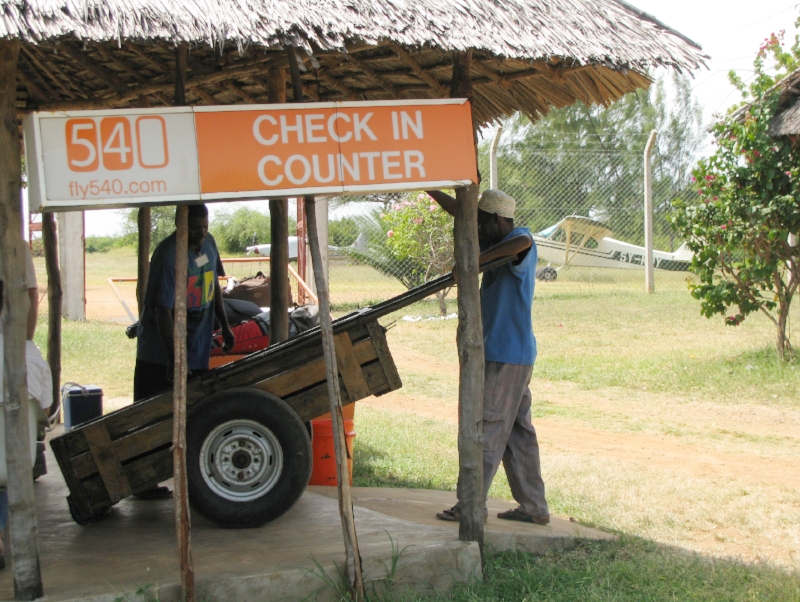5 min read
How did we end up here? We were running about in an African village on the shore of the Indian ocean, videotaping the villagers here in this 700-year old Swahili outpost. Just us and some rich western tourists milling about, mistakenly getting in our shots. Also, a few dressed-down celebrities here for the authenticity. We had been told to be respectful of the villagers and we thought we were. But a few of these poorest of the poor still looked down on us. I love moments like this. It’s a snapshot of God’s delight in producing endless variety… and humility.
All this was happening on Lamu Island – off the coast of Kenya. Me and the guys had taken a little twin-engine plane down the coast from Mombasa on Fly 540.
Fly 540 is a low-cost East African airline whose name comes from the fact that it initially cost 5,540 Kenyan shillings to fly from the capitol Nairobi to Mombasa.
I didn’t actually know what our flight from Mombasa to nearby Manda Island had cost as it was paid by our client, the Kenya Tourism Board. They had kindly sent us traipsing about the country to film Kenya’s endless beauty and daily incongruities.
The airport on Manda turned out to be an open air thatched hut. There, the luggage handlers grabbed our stuff and threw it into wheelbarrows, rolling them down to a tiny dock where a flat-bottomed skiff with an outboard motor waited.
As we cruised the narrow channel from Manda to Lamu Island in the late afternoon light, my fingers skimmed the cool water providing proof that we were really here. This little pocket tucked in the corner of the world is a near perfect portrayal of life on earth.
Lamu Old Town
How to explain the village of Lamu Old Town that was quickly approaching. Yes, it’s a UNESCO World Heritage Site… So are a thousand other places. But Lamu is distinct. Culturally, it’s a meeting of about 15 worlds coming together… and getting away with it.
Consider: Lamu, at 700 years is the oldest Swahili settlement in Africa. At one time a major trading post, its medieval alleyways and coral stone buildings hosted a buffet of Omani, Portuguese, Bantu, Arab, Persian, Indian and European traders.
But with all Lamu’s international flavor donkeys still comprise about a tenth of the population and, despite continual vigilance, one will inevitably squish onto their poop.
There’s a benign undercurrent of cultural dissonance here that is both charming and amazing in today’s world. Lamu maintains its conservative Muslim roots – you’ll pass women covered in full-length burqas strolling past one of the town’s 30 mosques.
Yet Lamu is often compared with St. Bart’s, Gstaad or some other indulgent getaway of the rich and famous. It’s become a prestige stop on their seasonal tour.
Because of religious constraints, there are few bars here. Yet you’ll find swinging royalty – both the European and Hollywood kind - frequenting Peponi’s for drinks at sunset or rambling along the endless, empty beaches. It’s Shariah Law meets Happy Hour. And everyone seems to get along.
We landed at Lamu’s shore just as traders had done since the 1300’s. But we weren’t bringing gold, ivory or spices… just our usual video gear. I suppose we were the equivalent of 14th century scribes or perhaps a medieval PR team. Just here to publicize Lamu’s fabulousness.
In no time we were initiated into the whirl of Lamu Town, exploring its labyrinth lanes, recording the street life of a Swahili culture that hasn’t changed much in hundreds of years. No cars are permitted here so it’s donkeys 24/7 to move your goods or your body around town.
We soon had an example of this as several boys careened down the alleyway atop two speeding donkeys. We flattened ourselves against a stone façade to make way. I felt a distinct squish underfoot. A sample of Lamu’s famous by-product injected into my open-toed Tevas with a warm squirt. It was an initiation into a timeless Lamu tradition - like my own circle of life.
Kipungani
We grabbed a lunch of local seafood served spicy Swahili style. I made sure to wash my soiled foot before sitting down at our beachfront restaurant and yet… there was still a whiff of something piquant in the air that most likely wasn’t coming from my plate. It seemed to hover about me like a small, stinky cloud.
But we had places to be and so bid farewell to the Beautiful People and the beautiful donkeys. We continued our Lamu journey, cramming ourselves back into the motorized dinghy, amongst piles of tripods and suitcases.
Like budding Magellans, we set upon the Indian Ocean circumnavigating Lamu Island. This was not too far from the border with Somalia and we heard there were a few isolated incidents with Somali pirates. It seemed preposterous that pirates would appear in these waters so close to the Kenyan shore and to chic Lamu.
Could the cultural forces that shaped this little dollop of paradise accommodate both Princess Caroline and… pirates? Were we blithely sailing through a Swahili Gilbert & Sullivan musical? Who knew? Our expectations here were constantly confounded.
But I was happy to see the thatched cottages of our new destination rapidly coming up. This was the Kipungani Explorer, a small collection of cottages along the shore. It was a resort… but a resort without hot water and only a few hours of electricity a day.
However, shortly after we landed we also located a pool, a bar and a restaurant. This was simple island style living… and yet, maybe not. Many of the resort’s help were from the neighboring village up the beach – also called Kipungani. And one of these rural villagers poured a very polished martini.
The villagers also helped build this new Kipungani with their centuries old techniques, utilizing wood from palm trees and weaving the leaves for roofs. It was they who constructed our cottages, also called bandas. There were lessons here. I quickly learned that first night if the food is good and the location exotic, you can be just as happy with a cool shower.
And electricity?… Frankly it’s overrated. Especially when you’re catching a sea breeze from your banda, overlooking an empty beach and an endless ocean. So, we’ll eat by candlelight. We’ll make do.
We were untethered, unconnected from the world. No cell signal. But consider this… We had a wonderful dinner surrounded by other tourists – some European, some Kenyan. We swapped stories and celebrated the food. So who knows? Maybe we were more connected.
By torchlight we all padded off to our bandas. Then it was the low-tech lullaby of the ocean’s waves that wrapped up this audacious day.
No Smoking Please
You might think wherever you happen to live is the cutting edge of healthy living. And maybe it is. But Kenya’s ambition can be surprising with its wholesome adoption of lifestyle trends. Take smoking. You can’t do it in public places. This doesn’t just include restaurants, theaters and shopping malls – the usual spots we pride ourselves in being smoke free.
In Kenya it also means no lighting up at rural lodges or even in the bush. No smoking on safari! This can make for some hilarious accommodating arrangements. The government has deemed that smoking is only allowed in specially sanctioned areas.
I believe it was after breakfast, I was walking along one of Kipungani’s pathways when I spotted a group of people, tourists and employees, out in a field. They stood huddled in a tiny hut – just four poles and a roof – furiously puffing away. This was the sanctioned smoking lounge.
There was nothing particularly special about the hut – it was just a little structure off to the side in a field. But under its thatched palm leaves permission was granted to indulge.
So I stood there in wonder, on this tiny island on the edge of the world, watching these people gathered together for their morning smoke. I was trying to figure out which aspect was more absurd - their tribal gathering of an after-breakfast smoking bee or their agreement to assemble in a field under a spindly make-believe hut just to have this moment. Ah, Africa….
The Actual Kipungani
As mentioned, the Kipugani resort was the privileged sibling of the actual, real, authentic Kipungani village just up the coast. At our client’s suggestion, we trooped up the beach to record rural life in this strictly Swahili – Muslim community.
I had met a nurse who worked in the village and ministered to the needs of the sickest and poorest there. I asked if I could interview her and she was hesitant to be photographed. However, after my mild but constant badgering she agreed under the condition that her face be fully covered – only her eyes would show through her dark cloth bui-buis. Some of the less religious locals referred to this as going “full Ninja”.
This lady was charming, very devout and devoted to her work. She spoke softly and conveyed as much through her eyes as her measured words. As I interviewed her, tourists would pop their heads into the little banda to check out what was going on.
Later, as we walked through the village videotaping its daily commotion, we must have over-stepped our sense of privilege and photographed too many faces, too many cute children, too much home life, too many personal moments. We tried to be careful… but maybe our footprint was a bit too large for this ancient village.
Back at the resort one of state handlers reprimanded me for my lack of respect of the villagers. There had been feedback. Oy…
This same person had previously reprimanded me because my cameraman had spoken to some of the resort’s guests, asking if he could photograph them. Apparently, that was also not allowed.
The Dhow is Up
Near sunset we boarded the resort’s dhow. This is a traditional vessel of the Arab and Indian world. Traders still use them to carry goods from the Persian Gulf to East Africa, using nothing but the power of the wind.
The ocean was still, the air golden – once again producing a calming effect upon us. Yet I still couldn’t shake the ironies of Lamu. Were we too loud and Westernish for the people in the neighboring Kipungani village but not humble enough for the resort’s guests?
I had no definitive answer as we glided on this sunset painted bay in the shadow of a dozen vivid cultures. I only knew that our time here had been strange, fun, a little crazy, a bit confusing and that… there was no need to worry about anything.
We felt only happiness and a sense of belonging as we sailed upon on these mad, beautiful waters.
If you enjoyed this post please 'like' or leave a comment below, and share with friends.















